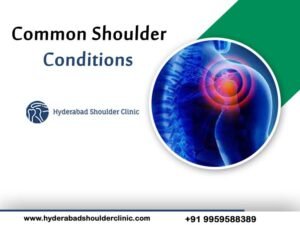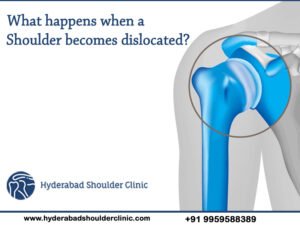Most of the time, we get relieved from the pain and stiffness of the shoulder by using pain relief medications and stretching steps without knowing the reason. By this, we may temporarily feel better, because of this we may find that the pain gradually returns or worsens. In this case, it is recommended not to use repeated self-medication, because this might indicate something more serious that is the frozen shoulder. Even though we don’t know why that happens, we should know a lot about what happens inside with the frozen shoulder.
It is important to take seriously about the initial shoulder discomfort treatment to avoid major problems. In this blog, Dr Chandra Sekhar Shoulder Replacement Surgeon in Hyderabad providing detailed information about the frozen shoulder, causes, symptoms, shoulder anatomy, and actual what happens internally during frozen shoulder.
What is Frozen Shoulder (Adhesive Capsulitis)?

Adhesive capsules are caused by stiffening of the shoulder due to scar tissue, resulting in painful movements and loss of motion. Frozen shoulder is the result of, scarring, inflammation, shrinkage of the capsule that surrounds the healthy shoulder joint and thickening, so that is the reason why it is known as an adhesive capsule.
The exact cause of the adhesive capsule is not yet known. Some believe that this is caused by inflammation, for example, when joint inflammation (synovitis) or by an autoimmune reaction when the body launches an “attack” on its tissues.
Other Possible Reasons for Causing Frozen Shoulder Are:
- After Surgery or Injury
- Other conditions and pain, such as, a rotator cuff tear, arthritis, tendinitis, or bursitis that has caused a person to rest shoulder without moving the shoulder
- If using sling after surgery or fracture that makes arm Immobilized
- Long-term shoulder joint immobility can cause a risk for people to develop frozen shoulders.
- In patients with risk factors for diabetes, chronic arthritis in the shoulder, or after breast or chest surgery, adhesive capsules are more common.
What are Frozen Shoulder Symptoms?

Frozen shoulder has three stages, each with different symptoms. The 3 Stages are:
Freezing:
The first phase is characterized by pain around the shoulder, followed by a progressive loss of range of motion. Sometimes referred to as the red phase because of the colour of the capsule (inflammation and bleeding) when undergoing arthroscopic surgery. This phase can last anywhere from 3 to 9 months. At this stage, aggressive treatment must be avoided.
Frozen
Phase two is the place where the pain goes, and stiffness dominates and gets worse. The initial transition from phase 1 to phase 2 can be painful. The late phase two is usually not painful, but shoulder functionally limiting because of its stiffness. It is also called as PINK because of the colour of the capsule when undergoing arthroscopic surgery. This phase can last anywhere from 9 to 15 months.
Thawing
Phase Three: During this last phase, there is a gradual return of the range of motion. It is also known as the white phase because of the colour of the capsule when undergoing arthroscopic surgery. The stage This can last anywhere from 15 to 24 months.
During Frozen Shoulder What Happens Internally
Before going to this let us first know about the anatomy of the shoulder
Shoulder Anatomy

About the shoulder joint, the first thing we need to know is a modified ball and socket joint. The ball is above the humerus, and the socket is a shallow cup at the end of the shoulder blade.
This is a good design that gives mobility to the shoulder joint but makes it unstable. For the shoulder stability, rotator cuff muscles support joints and also excess complex ligaments.
A bag like structure surrounding the shoulder joint (glenohumeral joint) is called a capsule. When the arm is lifted towards or above the head, the shoulder capsule is stretched fully, and when the hand is lowered, the capsule hangs in a small bag or a sack (plica).
Joint capsules known as synovial capsule contain up to 60 ml of synovial fluid (lining of the joint membrane produces synovial fluid). This fluid helps lubricate the joints and provides nutrients to repair the joint surface.
Now let us know what happens during the frozen shoulder by using the internal cameras during the “frozen” phase of the frozen shoulder, the capsule can shrink to less than half its normal size.
Adhesive Capsule

With Frozen Shoulder Syndrome, this small sack begins to attach itself, hence the name adhesive capsulitis.
When it becomes sticky, synovial fluid is drained and can often be reduced to around 5 ml. This drain makes the joint dry and brittle.
Massive localized inflammation occurs through adhesion. Through spreading other soft tissues of the shoulder causes inflammation and can cause swelling in other shoulder sacks. Often a frozen shoulder results from non-treated biceps tendonitis or triceps tendonitis.
In ball and socket joint, both biceps and triceps tendon runs. The tendon, like a muscle, is covered with cling film-like sheath, which gets inflamed and swollen so that the tendon can no longer glide smoothly when the arm moves. This quickly leads to a vicious. The tendon even swells more, and pain starts mostly at night time.
Inside the shoulder joint, there is very little free space, and finally, all the tendons sheaths blend slowly. This means that thousands of microscopic inflammatory cells can easily migrate from the sheath to sheath, and eventually, the entire shoulder leads to a massive inflammatory cycle.
Inflammation

This type of inflammation is feeling worse when at rest. That’s why pain is usually worse at night. Even with mild movements, swelling is generally disrupted, and the pain decreases.
In the case of frozen shoulder, some acute inflammation is there, but unfortunately, a more harmful type of inflammation is also observed. This is called chronic inflammation and has a different cell profile.
Chronic Inflammation

Anti-inflammatory drugs are very effective in reducing acute inflammation, but less so in chronic ones. This same also applies to steroid injections, which block the production of a key inflammatory component called prostaglandin.
This partly explains why tablets and injections have a limited effect on frozen shoulder syndrome.
Loss of Muscle Function:
With frozen shoulders, muscle loss occurs so quickly, lack of use cannot be a possible reason. Here are other factors, and they are more of a neurological possibility.
This case is also seen when someone breaks a bone. For example, if the arm is broken, the muscles cannot work within a few hours. This is not the result of inadequate use, but neurological phenomena.
This is because of the sensory-motor feedback loop. Sensory feedback from the joint is attenuated, and the muscles quickly lose their strength. This might be the result of a built-in protective mechanism.
In the case of a fracture, muscle weakness occurs rapidly, so we are forced to avoid lifting weights through the fractured joint. However, in the case of a frozen shoulder, a protected mechanism becomes resistance or obstruction, and the muscles of the hand remain stiff, and muscle function is lost, and unusable.
Conclusion
So, if you have frozen shoulders, we hope that this blog will help you understand what is happening internally in your shoulder joint. All of this may sound make you feel depressing, but remember that most cases can be treated with treatment protocols available at Dr Chandra Sekhar.
It is also convincing to know that frozen shoulders rarely return after you have them once. If you have any doubts regarding frozen shoulder and looking for the best treatment option, then contact Dr Chandra Sekhar.





